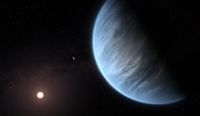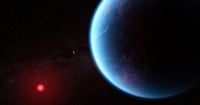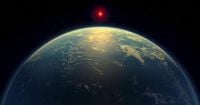In a groundbreaking discovery, scientists from Cambridge University have identified potential signs of life on the exoplanet K2-18b, located 124 light-years away from Earth. Utilizing the advanced capabilities of the James Webb Space Telescope (JWST), the researchers have detected molecules in the planet's atmosphere that could indicate the presence of life.
Professor Nikku Madhusudhan, who led the research team, described the finding as "the strongest hint we have ever seen in the history of science." The detection centers around the gases dimethyl sulfide (DMS) and dimethyl disulfide (DMDS), which are both associated with biological processes on Earth. Specifically, DMS is produced by marine microorganisms, such as phytoplankton, when they become stressed. This connection raises intriguing possibilities about the conditions on K2-18b, which is approximately 2.6 times the size of Earth and was first identified as a potentially habitable zone in 2015 by NASA’s Kepler Space Telescope.
According to Madhusudhan, no known non-biological processes can generate DMS in significant quantities. This leads the team to hypothesize that the molecules detected on K2-18b are indeed biological in origin. "So the simple assumption that we are making here is that these molecules are DMS or DMDS, or both," he explained during an interview with Channel 4 News.
While the discovery is monumental, Madhusudhan cautioned that they cannot yet confirm the existence of life. "What we are saying is that we have detected molecules that could potentially indicate the presence of life," he noted, emphasizing the need for further verification. The team aims to improve the detection significance to ensure that there is less than a one in a million chance that their findings are a fluke.
In addition to the scientific implications, the research also raises questions about communication with any potential life forms on K2-18b. Avi Loeb, a prominent astrophysicist at Harvard, pointed out that even if signals were sent to the planet, it would take at least 248 years for a response to arrive. "That's a long time. I'm not that patient to wait 248 years," Loeb quipped, suggesting that it might be more prudent to listen for any signals first.
Loeb also highlighted the importance of caution in interpreting the results. He stated, "There is still the lingering question of whether this could be produced by something else, and to be fully confident, physicists require a confidence level of five sigma, which is more like 99.99%." He noted that similar molecules have been found on comets, which do not harbor life, indicating that geological and chemical processes could also be responsible for their presence.
The research team’s methodology involved the transit technique, where the starlight passing through the planet's atmosphere is analyzed. The absorption features of the starlight can reveal the composition of the atmosphere, allowing scientists to estimate the molecules present.
Despite the cautious optimism surrounding the discovery, Madhusudhan and his colleagues acknowledge that more research is necessary. "This is a very important first step, and this is the strongest hints we have ever seen for such molecules outside the solar system," he stated. The next steps involve conducting more theoretical studies to better associate the detected molecules with potential life.
If confirmed, the implications of this discovery could be profound. Madhusudhan suggested that such findings would lead to a general assessment that life could be common in the universe, even if it is predominantly microbial. However, the vast distances involved mean that any potential communication with life forms on K2-18b remains a distant dream.
As the scientific community eagerly awaits further developments, the discovery of K2-18b stands as a testament to the capabilities of modern astronomy and the ongoing quest to answer one of humanity's oldest questions: Are we alone in the universe?
This article was published on April 18, 2025.







